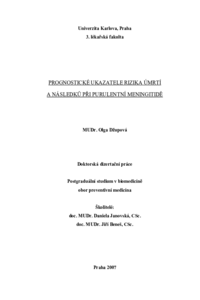Prognostické ukazatele rizika úmrtí a následků při purulentní meningitidě
Prognostic indicators of risk of death and the consequences of purulent meningitis
dissertation thesis (DEFENDED)

View/
Permanent link
http://hdl.handle.net/20.500.11956/13662Identifiers
Study Information System: 13851
Collections
- Kvalifikační práce [3205]
Author
Advisor
Consultant
Beneš, Jiří
Referee
Křížová, Pavla
Marešová, Vilma
Dostál, Václav
Faculty / Institute
Third Faculty of Medicine
Discipline
-
Department
Department of Epidemiology and Biostatistics 3FM CU
Date of defense
26. 9. 2007
Publisher
Univerzita Karlova, 3. lékařská fakultaLanguage
Czech
Grade
Pass
Purulentní meningitida je akutní život ohrožující infekční onemocnění centrálního nervového systému. V předantibiotické éře byla smrtnost nemoci téměř stoprocentní; s objevem antibiotik a jejich zavedením do léčebné praxe v 30.-50. letech minulého století dramaticky poklesla. V posledních desetiletích však i přes používání vysoce účinných antibiotik a postupů intenzivní péče nedošlo k významnému snížení smrtnosti a následků způsobených touto chorobou. Smrtelný průběh nemoci postihuje 15-30 % nemocných v dospělém věku. Přestože není častou infekční diagnózou, patří do první desítky infekčních příčin úmrtí ve světě. Cílem studie bylo na základě zhodnocení vlastního souboru pacientů zjistit prognostický význam sledovaných faktorů anamnézy, průběhu onemocnění a laboratorních charakteristik pro klinický výsledek nemoci u dospělých pacientů.
Purulent meningitis is a life-threatening acute infectious disease of the central nervous system. In preantibiotics period was almost one hundred percent fatality rate of disease, with the discovery of antibiotics and their introduction into medical practice in 30th-50th of the last century has decreased dramatically. In recent decades, despite the use of highly effective antibiotics and intensive care procedures, there was no significant reduction in mortality rate and consequences of the disease. Lethal course of the disease affects 15-30% of patients in adulthood. Although not a common infection diagnosis among the top ten infectious causes of death worldwide. The study was based on evaluation of their own group of patients to determine prognostic factors observed history, course of illness and laboratory characteristics of the clinical outcome of disease in adults.
